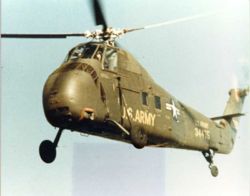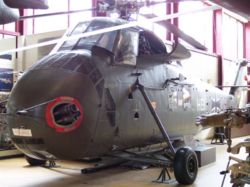PlaneSpottingWorld welcomes all new members! Please gives your ideas at the Terminal.
Sikorsky H-34
| Sikorsky H-34/S-58 | |
|---|---|
| Type | helicopter |
| Manufacturer | Sikorsky Aircraft |
| Maiden flight | March 8, 1954. |
| Primary users | United States Army US Navy |
| Developed from | H-19 Chickasaw |
| Variants | Westland Wessex |
The Sikorsky H-34 Choctaw (also known as the Sikorsky S-58) was a military helicopter originally designed for the US Navy for service in the anti-submarine warfare (ASW) role.
Contents
Development
The Sikorsky S-58 was developed from the Sikorsky's UH-19 Chickasaw. The aircraft first flew on March 8, 1954. It was initially designated HSS-1 Seabat (in its anti-submarine configuration) and HUS-1 Seahorse (in its utility transport configuration) under the US Navy designation system. Under the US Army's system, also used by the fledgling US Air Force, the helicopter was designated H-34. The US Army applied the name Choctaw to the helicopter. In 1962, under the new unified system, the Seabat was redesignated SH-34, the Seahorse as the UH-34, and the Choctaw as the CH-34.
Roles included utility transport, anti-submarine warfare, search and rescue, and VIP transport. In it standard configuration transport versions could carry 12 to 16 troops, or eight stretcher cases if utilized in the MedEvac role, while VIP transports carried significantly less people in significantly greater comfort.
Service
The U.S. Coast Guard flew these helicopters from 1959 to 1962. The H-34's lift capacity was just sufficient enough to lift a Mercury capsule. In 1961 the hatch of Mercury 4 was untimely detached and the capsule was filled with seawater. That extra weight was too much for the H-34 and Liberty Bell 7 was emergency released (in the deep sea).
Vietnam
French evaluations on the reported ground fire vulnerabilities of the CH-34 may have influenced the U.S. Army's decision to deploy the CH-21 Shawnee to Vietnam instead of the CH-34, pending the introduction into widespread service of the Bell UH-1 Iroquois. However, the approximately twenty Army H-34s that did eventually reach Vietnam proved no more vulnerable to ground fire than any other rotary-wing aircraft in the theater, and the CH-34 successfully carried out missions ranging from combat assault to aeromedical evacuation and general cargo transport.
The US Marine Corps continued to use the H-34 pattern even after the US Army had phased it out. Even after the USMC adopted their own version of the UH-1, the UH-1E, the CH-34s continued to up to and for a period after the Tet Offensive in 1968. Marine Corps H-34s were also among the first gunship helicopters trialed in theatre, being fitted with the "Temporary Kit-1" or TK-1, comprised of 4 M60C machine guns and two 19 shot 2.75 inch rocket pods. The operations were met with mixed enthusiasm, and the armed H-34s, known as "Stingers" were quickly phased out. The TK-1 kit would form the basis of the TK-2 kit used on the UH-1E helicopters of the USMC.
Most of the twenty surviving CH-34 helicopters were turned over to the South Vietnamese during the course of the war, though a few were ultimately reclaimed by the Army prior to the final collapse of the Saigon Government.
Post-Vietnam
The CH-34 Choctaw remained in frontline Army service well into the late 1960s, and was standard equipment in many Army Reserve and National Guard aviation units for considerably longer. Indeed, the last Choctaw was not officially retired until the early 1970s. Sikorsky production ceased in 1970, with 1,800 built.
Other countries
The French Navy adopted the SH-34 Seabat in 1955, using the helicopter during the Algerian War of 1956-62. The French Army had earlier modified the H-19 and Piasecki H-21 with rockets and machine guns for use in a ground attack role; the French Navy performed the same modification to the CH-34. The H-19 proved underpowered for the ground attack role, and the H-21 lacked mobility. The H-34 was able to carry more armament, including a MG151 20 mm cannon firing from the cabin door, two 12.7 mm machine guns firing from the cabin windows to port, and batteries of 37- or 68-mm rockets. 73 mm rockets and additional machine guns were also employed on some versions. Official evaluations at the time had indicated that the CH-21 was more likely to survive multiple hits by ground fire than was the CH-34; this was assumed to be a consequence of the location and construction of the CH-34's fuel tanks.
The CH-34 was also built and developed under license from 1958 in the United Kingdom by Westland Aircraft as the turbine engined Wessex which was used by the Royal Navy. The RN Wessex was fitted out with weapons and ASW equipment for use in an antisubmarine role. The RAF used the Wessex, with turboshaft engines, as an air/sea rescue helicopter and as troop transporter. Wessexes were also exported to other countries and produced for civilian use.
Military Operators
- Template:ARG
- Template:BEL
- Template:BRA
- Template:CAM
- Template:CAN
- Template:CHI
- Template:ROC
- Template:CRC
- Template:FRA
- Template:GER
- Template:HAI
- Template:IDN
- Template:ITA
- Template:ISR
- Template:JPN
 Katanga
Katanga- Template:LAO
- Template:NLD
- Template:NIC
- Template:PHI
 South Vietnam
South Vietnam- Template:SPA
- Template:TUR
- Template:THA
- Template:USA: USAF, US Army, US Marines, US Navy, US Coast Guard
- Template:URU
Specifications (H-34 Choctaw)
General characteristics
- Crew: 2
- Capacity: 16 troops or 8 stretchers
- Length: 56 ft 8.5 in (17.28 m)
- Rotor diameter: 56 ft 0 in (17.07 m)
- Height: 15 ft 11 in (4.85 m)
- Disc area: ft² (m²)
- Empty weight: 7,900 lb (3,583 kg)
- Max takeoff weight: 14,000 lb (6,350 kg)
- Powerplant: 1× Wright R-1820-84 radial engine, hp (kW)
Performance
- Maximum speed: 123 mph (107 knots, 198 km/h)
- Range: 293 km (182 mi)
Trivia
- In the 1990's, an H-34 called Miss Piggy flew passengers from JFK Airport to downtown Manhattan.
- The TV series Riptide (TV series) starring Joe Penny, Perry King and Thom Bray featured a CH-34.
- The 1994 movie Guarding Tess featured an S-58DT, tail number N90935.
- The 1987 film "Full Metal Jacket" directed by Stanley Kubrick featured the CH-34 although it was actually the Westland Wessex disguised as the CH-34 due to the Gas-turbines.
References
- Duke, R.A., Helicopter Operations in Algeria [Trans. French], Dept. of the Army (1959)
- Leuliette, Pierre, St. Michael and the Dragon: Memoirs of a Paratrooper, New York:Houghton Mifflin (1964)
- Riley, David, French Helicopter Operations in Algeria, Marine Corps Gazette, February 1958, pp. 21-26.
- Shrader, Charles R. The First Helicopter War: Logistics and Mobility in Algeria, 1954-1962, Westport, CT: Praeger Publishers (1999)
- Spenser, Jay P., Whirlybirds: A History of the U.S. Helicopter Pioneers, Seattle, WA: University of Washington Press (1998)
Related content
Related development
Designation sequence
- Sikorsky:
- U.S. Military:
Related lists
Lists relating to aviation | |
|---|---|
| General | Timeline of aviation · Aircraft · Aircraft manufacturers · Aircraft engines · Aircraft engine manufacturers · Airports · Airlines |
| Military | Air forces · Aircraft weapons · Missiles · Unmanned aerial vehicles (UAVs) · Experimental aircraft |
| Notable incidents and accidents | Military aviation · Airliners · General aviation · Famous aviation-related deaths |
| Records | Flight airspeed record · Flight distance record · Flight altitude record · Flight endurance record · Most produced aircraft |



